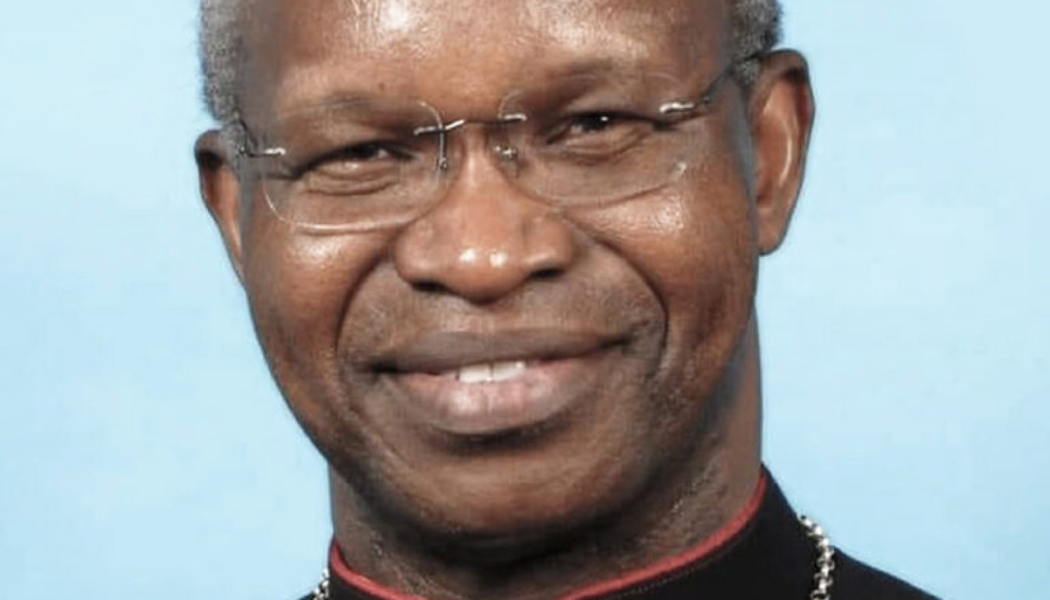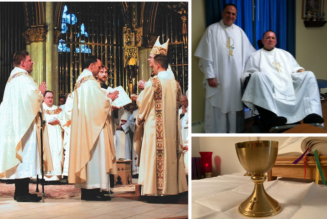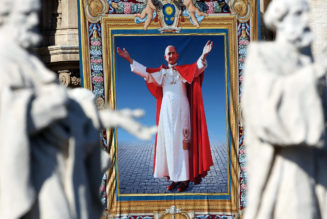Hey everybody,
Today is the Feast of St. Nicholas, and I hope you found some very nice pieces of candy in your shoe this morning. I certainly did.
The Tuesday Pillar Post is coming to your inbox a bit late this morning, because I am in California today, and I just couldn’t compete with the time difference. Sorry, East Coasters – but you can still enjoy reading The Tuesday Pillar Post on your lunch hour!
The news
First, as I mentioned, today is the Feast of St. Nicholas – which, to my mind, is always when Advent really kicks into high gear, and when I remember that I’d better start obtaining gifts for the people I love.
A lot of people tend to remember St. Nicholas for the legend that he punched Arius the heretic during the Council of Nicea. It’s probably not true that Jolly Ol’ St. Nicholas really walloped Arius, but there’s more to the Saint-Who-Became-Santa than the punch that probably wasn’t.
In the manner of hermits, Bishop Muricken doesn’t talk on the telephone much these days, but he agreed to answer some questions from The Pillar, presented by a local priest.
The hermit-bishop of Pala is known for his asceticism: walking around barefoot and eating one meal a day. He also donated a kidney to a Hindu man who had been forced to sell his house to cover treatment costs.
He answered questions for The Pillar about all of that, and offered some advice for the rest of us Catholics, who are seeking holiness in everyday life, but are probably unlikely to sign up for the eremitical life.
You can read that advice, and more about the life of a hermit, in this very good interview.
So The Pillar this week brings you an explainer on the actual state of the case for the actual defendants — just the facts you need to know if you want to know how the trial is going.
Of course, this is an actually complicated case, with 10 defendants and dozens of charges – so even a simple explanation can get pretty complex. But we tried to pare it all down for you.
—
Also complex, and much like a soap opera, are the continuing machinations of the German synodal way.
In fact, a synodal way leader explained on Friday directly that organizers of the German process have intentionally used their “synod” to pressure the Church to change Catholic doctrine. It was a surprisingly candid and detailed admission — read The Pillar’s report to get up to speed.
As it happens, the case bears similarity to a number of abuse scandals at the moment — Rupnik faced restrictions on his ministry that seemed not to restrict him, the Holy See has actually received numerous complaints against the priest, and he has personal and professional ties to the very people who decided not to impose canonical sanctions against him.
Does any of that sound familiar? It should. In fact, the most striking thing about the Rupnik situation is exactly how similar it is to several other abuse allegation scandals operative in the Church right now — all of which are painting a rather bleak mosaic of the progress on the Church’s commitment to ecclesiastical reform and the rule of law.
You can read my analysis of the situation, right here.
💡
Death’s cold grip
In the Great White North, Canada’s crisis of assisted suicide is on the verge of becoming much worse than it already is.
Beginning March 17 – just in a bit more than three months – assisted suicide will be open to all Canadians suffering from “grave and irremediable” mental illnesses.
In Canada, even many advocates of assisted suicide say this will probably not go well.
One bioethicist who supports assisted suicide laws says the system will facilitate the deaths of “people who have decades left to live … fueled by poverty, isolation [or] loneliness to seek MAiD,” or “Medical Assistance in Dying.”
You might be wondering what “grave” or “irremediable” means in this context, by the way. So are some of those bioethicists, who say the terms are so broad that people with transient mental health problems might be talked into it, even when they’re having treatable bouts of depression.
Of course, it doesn’t matter whether Canadians are experiencing permanent or transitory mental health problems — none of them should be encouraged by their government to die, or assisted with suicide for that matter, but, indeed, it’s happening.
Consider recent testimony from Christine Gauthier, a Canadian military veteran who was disabled during her decade as an artillery corporal. Gauthier is a five-time world para-canoe champion, and a sledge hockey-playing motorcyclist.
This is, as the Canadians say, a pretty “bad-ass broad.” (Again, that’s a Canadian expression. It’s not mine.)
But she testified last month to the Canadian House of Commons that while she spent five years fighting the Veteran Affairs Department for a wheelchair ramp, the department eventually offered, in writing, some assistance in taking her life.
That’s right. What country among you, if a veteran asks for a ramp, offers suicide instead?
Canada, apparently.
Of course, the government has apologized, and said Gauthier’s experience was an isolated incident with a bad employee.
Except it really wasn’t.
That’s right. A guy called up and said he had PTSD, and an employee apparently said he could always apply for assisted suicide if things were pretty bad.
The department apologized, acknowledging that “medical assistance in dying was discussed inappropriately” with the veteran.
Veterans Affairs “deeply regrets what transpired.”
I’m willing to bet the struggling former soldier with some mental health problems regretted it all the more when an agent of his government suggested he just go quietly in the long good night.
It can be easy to blame Canada for all this, or to think it’s a uniquely Canadian problem.
I mean, seriously, this is the country wherein a DEPARTMENT STORE last month ran a three-minute commercial, gauzily (and religiously) promoting assisted suicide.
But this is not a uniquely Canadian problem, and we’d be kidding ourselves to think the crisis won’t happen in the United States.
In 2021, 10,064 Canadians died by assisted suicide. At least 1,300 Americans suffered the same fate. But domestic numbers are rising, and a growing number of states are discussing legalizing the practice.
As Christians, we’re called to compassion – “suffering with” – people who are suffering. And as we march toward dystopia – with Canada ahead by a few paces – that call will become more unusual, socially unacceptable, and demanding. But we have to do it. We’re facing the demographic reality that a huge number of people will likely be pushed into assisted suicide as they grow older, that normalizing death by suicide, with a doctor’s help, will continue to become commonplace.
Canadian bishops are speaking out.
“Next March, unless the government is forced to change its mind, persons suffering solely from mental illness will become eligible for euthanasia. In six years, Canada has gone from totally banning euthanasia to one of the most permissive euthanasia regimes in the world. Allowing ‘mature minors’ access may come next,” Archbishop J. Michael Miller said last month.
We Christians need to decide that we’ll be set apart by our solidarity with the aging, the terminally ill, and the mentally ill. Not only that we defend their dignity in the cultural and political sphere, but that we take it upon ourselves – we make it the mission of believers – that we sit with suffering people in sickness, that we roll up our sleeves and wash their sores and keep them company.
Matthew 25 makes clear that kind of compassion is expected of Christians, and a way of loving the Savior.
We actually need to sit vigil with the suffering, as the prowling lion licks its lips at the prospect of robbing from them the terrifying gift and mystery of suffering, in service to a false god called “comfort.”
Here’s John Paul II:
“To concur with the intention of another person to commit suicide and to help in carrying it out through so-called ‘assisted suicide’ means to cooperate in, and at times to be the actual perpetrator of, an injustice which can never be excused, even if it is requested. In a remarkably relevant passage Saint Augustine writes that ‘it is never licit to kill another: even if he should wish it, indeed if he request it because, hanging between life and death, he begs for help in freeing the soul struggling against the bonds of the body and longing to be released; nor is it licit even when a sick person is no longer able to live.’”
“Even when not motivated by a selfish refusal to be burdened with the life of someone who is suffering, euthanasia must be called a false mercy, and indeed a disturbing ‘perversion’ of mercy. True ‘compassion’ leads to sharing another’s pain; it does not kill the person whose suffering we cannot bear. Moreover, the act of euthanasia appears all the more perverse if it is carried out by those, like relatives, who are supposed to treat a family member with patience and love, or by those, such as doctors, who by virtue of their specific profession are supposed to care for the sick person even in the most painful terminal stages.”
—
‘They’re making a list’
Between now and the end of the year, you can count on reading two things from most media outlets each December.
First, gift-giving guides, chock full of the products, books, and giving opportunities pitched all year by publicists, and thrown into a roundup each December by editors who feel guilty they didn’t take any of the pitches.
Second: lists.
In December, journalists love lists. They make them. They check them twice. You get the idea.
And they especially love to make lists of influential people.
Catholic journalists are no exception. This means that readers like you can expect this time of year to start seeing lists published everywhere, purporting to list things like “The 22 Catholic newsmakers of ‘22,” among other such gimmicks.
Many of those lists will purport to identify the kind of Catholics who – the journalists say – are “influencing” the life, policy, leadership, or governance of the Church.
But those lists will mostly be wrong.
Why?
Because the lists are mostly made to curry favor from the people who are placed on them – Nearly everyone, after all, loves to be listed among the “Most influential Catholics of the 21st century so far.”
So journalists make the lists, and then the people on the lists tweet out the lists, saying how they’re “so humbled,” or “so undeserving” — but also making sure that everyone can see their name is on an important list of important people.
Duly and appropriately flattered, when the journalist comes calling in February or March for an interview, an introduction, or a bit of gossip, the person on the list will pick up the phone.
You list my name, I’ll remember yours. You get the idea.
Journalism is an industry, you see, and this is its tradecraft.
Here’s the problem: The people who actually do make a difference in the policy, governance, leadership, and life of the Church often want to avoid being on any kind of a list — they’re the kind of people well-respected by decision-makers of all kinds, usually because they don’t seek out the spotlight. They do a job, they do it quietly, they do it well, and that garners them some measure of respect.
That doesn’t often lead to placement on a list. But we thought maybe it should.
In the past few weeks, we at The Pillar have talked about the idea of producing a list of the “Top-Ten-People-Most-People-Haven’t-Heard-Of-But-Are-Actually-Running-Everything.”
We decided against it.
Why?
Well, those people don’t want to be on a damn list.
It might call the wrong kind of attention to the influential work they’re doing, and that will run the risk it will get messed up, and they really can’t afford to have that happen. Or, they wouldn’t mind being on the list, but their boss wouldn’t love for them to be on The Pillar’s list, so they’d rather we not broadcast that we know them.
Or, in a lot of cases, they don’t actually agree about how important/impactful/respected they are, and they’d be frustrated to be put on the list in the first place. That’s called humility, we think.
PLUS – to the extent that we know any people who are really impacting things that matter, and we have their trust and respect, we don’t want to give away their contact info to our competition. That’d be just crazy, right?
So we decided not to make a list.
But we thought we’d explain what the lists usually get wrong about who is influencing policies and decisions in Church leadership — and how they could get it right in the future. If the listmakers are listening, that is.
So here goes.
The typical “influential Catholics” list — and what it gets wrong
Number 1: Cardinal E.M. Eritus
Typical list: Cardinal E.M. Eritus might be retired, but he is a courageous figure who is willing to tell truths other people won’t. While he no longer runs a diocese, he is an important leader on the left/right, who has the attention of the pope and can get things done in Rome. A lot of important decisions run through Cardinal Eritus, especially on [some big public issue he spoke out about].
The Pillar: Cardinal E.M. Eritus is retired! He probably doesn’t want to be influential on Church policy anymore, and he probably isn’t following it very carefully these days. If he’s anything like most retired bishops, he is likely hitting the confirmation circuit, playing some golf, and celebrating the weddings of his siblings’ grandchildren. Sure, he “spoke out” on a major issue, but that’s because a nice reporter asked for an interview, and he was too polite to say no — he certainly didn’t mean to make a fuss, and he really hasn’t been keeping up too much on Vatican/USCCB/Capitol Hill politics anymore. He’s retired, after all.
Number 2: Legacy Media Pundit
Typical list: Legacy Media Pundit writes a regular blog post on the website of an established Catholic print newspaper, weighing in the cultural and political issues of the day from the perspective of his faith. He regularly cites Aquinas/Rahner/Lonergan/Denzinger, so you know he’s serious — plus, he’s got a certain editorial flair that makes him just a bit sassy as he pontificates on all the serious issues du jour.
The Pillar: The bishops who agree with his opinions like Legacy Media Columnist pretty well, and they occasionally send around one of his posts to their friend’s inboxes. But unless he’s one of the very few with much actual Church experience, he’s usually paying more attention to Capitol Hill than to the ecclesiastical issues bishops address. And on both secular and ecclesiastical politics, his opinions are pretty predictable — he loves the policies of his friends, and he loathes the ideas of their political adversaries. Good for a nice dose of confirmation bias, but rarely a factor in the actual running of things within the bishops’ control.
Number 3: New Media ‘Influencer’
Typical list: New Media Influencer has over 200,000 followers on YouTube, and more than triple the Instagram audience of his local diocese. He’s got very nice suits, or maybe a toupée, or some other distinguishing physical feature.
He talks with a lot of confidence about what the Church should do. He regularly reminds his listeners that he’s the only voice they can trust, and he seems really, really mad. I mean really mad.
So that probably means he’s right, right?
The Pillar: He does have a lot of followers on social media, true. But a lot of bishops are still trying to figure out the difference between direct messages and public posts, you know? The ones who are social media savvy usually aren’t much influenced by the “angry social media schtick” — with just a few exceptions.
In fact, a number of bishops have heard the name of New Media Influencer, but they can’t remember if he’s the guy with the big swoop of hair, the guy who thinks women shouldn’t work, the guy who said women should be priests, or the guy who said something unkind about their seminary. In either case, decision-makers in the Church probably aren’t this influencer’s audience.
Number 4: “Catholics for Doctrinal Change”
Typical list: This well-funded advocacy group conducted a major campaign this year to see the Church change some of its established and perennially held doctrine. With supporters ranging from Catholic politicians to non-Catholic pseudo-celebrities, this advocacy group took an interested millionaire’s money and made some very clever social media posts. Plus, they had a rally at the bishops’ meeting.
The Pillar: When bishops hear “doctrinal change,” it’s usually a sine qua non — even sympathetic bishops aren’t actually going to defy the Church because a lobbying group urged them to. A few might be polite, but even the “listening Church” is hardly listening to campaigns from “Catholics for Doctrinal Change,” or its counterpart, the “Doctrinal Change Coalition.”
Number 5: The guy chosen to play Jesus in a movie/ a TV show / any other Jesus production
Typical list: The actors who play Jesus eventually begin speaking at Catholic events and conferences, and seem sincere about the way portraying the Lord deepened their relationships with the Lord.
They also seem sincere about reaching out to bishops regarding their concerns and observations concerning some elements of the Church’s life – and about speaking on them in interviews with Catholic media. No pressure, of course — even if those opinions are coming from a guy who looks an awful lot like the Big Guy did, in that one movie at least.
The Pillar: Listmakers love celebrities. If you see an “influencer” list, you can pretty well count on it being rounded out with a few actors — and for Catholic lists, that will definitely mean a guy or two who played Jesus. But believe it or not, bishops don’t always see the latest TV/movie/streaming series production of Christ’s life, and when they do, they are usually able to distinguish between the actor and the Lord.
Number 6: Princess Gertwhicke III of Genovia
Typical list: Did you know that Princess Gertwhicke III of Genovia is actually a practicing Catholic? We grant, of course, that she’s not the royal princess or heir apparent of Genovia – that’s Princess Mia – but Gertwhicke III is a member of the Royal Family, a somewhat regular Mass-goer, and a Formula 1 racing fanatic.
Plus – get this – Gertwhicke III has got some very strong opinions on Vatican II, and she’s willing to appear at a conference near you to explain them with conviction, if not detail.
Sure, you’ve never heard of Genovia, but being princess of a very tiny European nation – a principality, really – is nothing to sneeze at.
The Pillar: Actually, some of us would like to meet a princess. Gertwhicke III will probably make our list too.
An actual ‘influencers’ list
If we were going to make a list of who actually influences policy-makers in the life of the Church, here’s some of the folks we’d put on it. For better, in some cases, or for worse:
Other bishops
Bishops and other policymakers are often influenced by the practices, approaches, and policies of the friends they look up to and admire. This doesn’t necessarily mean other bishops with leadership positions at the bishops’ conference, or in the metropolitan province – it means bishops who have garnered the respect of their peeers because of their character, ability, or experience, or bishops who come from the same networks and social groups.
A friend remarked to The Pillar recently that it’s amazing “who you knew in seminary” can influence how you approach things in your later ministry. In our observation that’s true – even, or especially, among bishops!
USCCB staffers
At the U.S. bishops’ conference, staffers are reminded often that the conference’s activity should be “directed by the bishops,” or “set by the [conference] strategic plan,” rather than be “staff-driven.” Most USCCB staffers seem to take those reminders to heart.
Even still, there is a cadre of lay and clerical staffers at the USCCB with the respect of a broad swath of bishops, and the ability to get bishops talking about issues quickly – and even releasing USCCB statements on those issues – because those staffers have the reputation of working, more than once, to save the bishops’ bacon on some critical issues.
Diocesan advisory boards
In every U.S. diocese, bishops are advised by two groups of experts who tend to wield a great deal of influence on what the bishop actually does — the diocesan finance council and the diocesan review board.
The finance council has a lot of influence over the budget, and the review board advises on serious personnel matters — what to do with priests accused of various kinds of misconduct. In fact, since McCarrick, the mission of many review boards has expanded, or bishops have established new “Conduct/Ministry/Personnel Advisory Boards” of lay people, advising on priests accused of misconduct which does not involve minors.
In the case of both the finance council and the review board, diocesan bishops tend to listen — and once the boards formally advise something, bishops tend to do it. In fact, most diocesan staffers, diocesan priests, or Catholic-media-types have heard bishops of all types tell them: “I can’t go against the advice of the review board,” or “This is how the financial council says we should do it.”
Bishops are also advised by presbyteral councils — groups of elected and appointed priests the bishop is required to consult with. But while bishops hold meetings with them, they don’t always seem to occupy the same rarified status in diocesan policy-making.
For what it’s worth, we at The Pillar have rarely – if ever – heard a diocesan bishop say: “I can’t go against the presbyteral council on this one.”
Insurance companies
Here’s a fact you might not think about a lot: the ministry of dioceses, parishes, religious orders comes with a fair amount of legal liability — people are constantly walking in places where they might trip and fall, accusations tend to be followed by litigation, and in the pandemic, many ecclesial staffers learned that saying things for or against social distancing, vaccinations, masking, or even coming to Mass could be construed as a kind of medical advice, and could be taken as an occasion of liability.
So the advice of insurance companies that work with Catholic institutions – the Catholic Mutual Group most prominently – wields a lot of influence in diocesan and parish policy, on everything from construction and renovation management to parish pandemic responses.
If it’s helpful in any organization to “follow the money,” it’s also helpful to remember how much of that money flows through insurance companies — and to understand how that might shape some of the most interesting stories unfolding in the life of the Church.
Diocesan and parish staffers (sometimes)
It’s not easy being a diocesan or parish staffer — or working at any level of the Church’s institutions, actually. But diocesan and parish staffers are on the ground where the work gets done, and often while dealing with a challenging set of obstacles along the way. And good policymakers know that if you’re the one with your sleeves rolled up, doing the work of the parish or the diocesan ministry program, you’ve seen a lot, and you’ve got a pretty good sense of what will work and won’t.
That’s why good policymakers consult regularly with the ministry and administrative staff getting things done. Maybe that’s “synodality” — or maybe it’s just good staff management. Prudent Church leaders know that staffers – and volunteers – who feel heard also feel more engaged, energized, and committed in their work, and are therefore more likely to keep at it.
Plus, there are usually very good ideas germinating in the experience of day-to-day ministry and administrative work of the Church.
Nuns
Ok. This one should be a gimme. And it’s the most important answer.
Everyone Catholic knows that if anything gets done in the life of the Church, it’s only because of the legion of cloistered and contemplative religious sisters praying daily for the holiness of the Church.
They’re pretty much the secret sauce of it all.
So if you really want to know who the Catholic influencers are, consider what’s happening inside the convent of a Carmel or a Poor Clares monastery. They’re the ones making things happen — and they usually make a very good batch of fudge to boot!
—
Varia
Before we conclude, a customary thank you to those of you who have in recent weeks become paying subscribers to The Pillar, allowing us to continue doing the work that we do.
If I may, I’d like to ask a favor of all you, paying and non-paying subscribers alike. Here’s the favor: The Pillar grows when readers pass on our coverage to their friends, or encourage other people to sign up for our twice-weekly (and always delightful) newsletters, The Tuesday and Friday Pillar Posts.
We want to continue growing, of course, so that we can continue to expand our mission in the life of the Church, and continue staying in business as well. We also sincerely believe in our project, and in the journalism we make, and we think you probably do too.
So today – consider it a St. Nicholas Day treat – would you consider passing on this Pillar Post to a friend who might enjoy it, or posting it on social media, and encouraging your friends to subscribe – for free – to The Pillar, and to give it a try.
We’d like to keep expanding the number of Catholics who get these newsletters, and we’d like your help in doing it. So if you would, stick our newsletter in someone’s stocking day, and encourage them to sign up — we’d be really grateful.
—
Also, if you’re looking for spiritually helpful Advent content, don’t miss the first two episodes of our Advent mini-season of Sunday School, our Bible study podcast. We’re learning a lot about Elizabeth and Zechariah, Mary and Joseph, and Anna and Simeon.
Listen to Sunday School right here, or wherever you get your podcasts.
—
Finally, would you join me in praying for the soul of Cardinal Richard Kuuia Baawobr, a Ghanian cardinal who died in Rome Nov. 27, at age 63?
When Cardinal Baawobr was named to the College of Cardinals last year, I was intrigued that a bishop from Wa, a rural diocese in Ghana’s northwest, would be appointed to become a papal collaborator and elector. So I wrote to Cardinal Baawobr, and asked him if I might come to his diocese, follow him around for a couple of days, and write a profile about a cardinal’s ministry in rural Ghana.
To my great delight, the cardinal said yes, and asked me to schedule the visit for sometime after this year’s consistory. Except he got sick during his trip to Rome, entered a Roman hospital, and was actually discharged just a week before his death.
He struck me, in the brief exchanges we had, as a generous and kind man. I know that those in his presbyterate with whom I spoke certainly thought well of him.
In your kindness, please pray for the eternal salvation of his soul.
And as always, please be assured of our prayers. And please pray for us. We need it!
Jolly ol’ St. Nicholas, pray for us!
In Christ,
JD Flynn
editor-in-chief
The Pillar
💡
Join Our Telegram Group : Salvation & Prosperity









